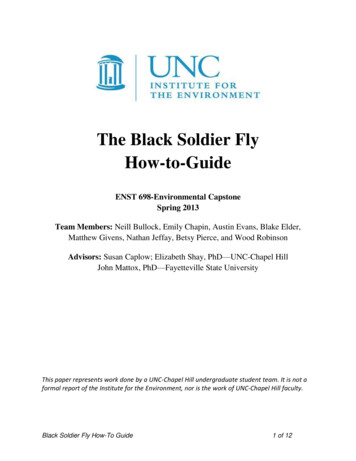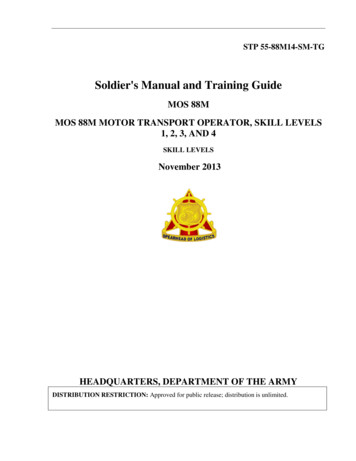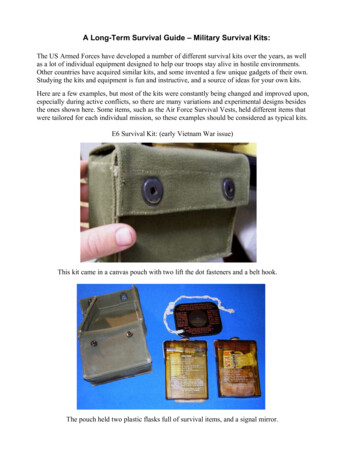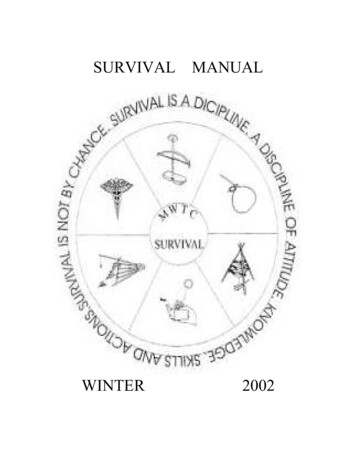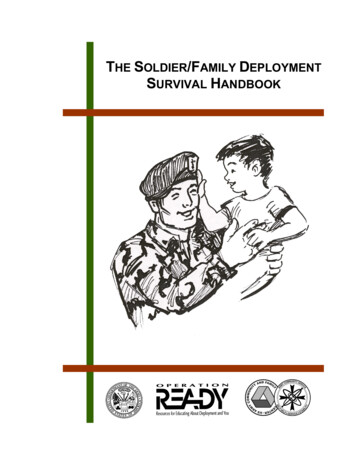
Transcription
THE SOLDIER/FAMILY DEPLOYMENTSURVIVAL HANDBOOK
The Soldier/Family DeploymentSurvival HandbookFamily Deployment Readiness for the Active Army,the Army National Guard, and the Army ReserveThis handbook is a new publication of the Operation READY (Resources for Educating aboutDeployment and You) materials developed under a contract with Headquarters, Department ofthe Army, Community and Family Support Center, and the Texas Cooperative Extension of theTexas A&M University System.Grant Administrator and Project Directorfor Texas Cooperative ExtensionNancy GranovskyProject ManagerGranville E. (Gene) TysonEditor and DesignSusan LeeProduction CoordinatorDiane WisneskiCover IllustratorEmma StarkOperation READY:Resources for Educating About Deployment and YouTexas Cooperative ExtensionThe Texas A&M University Systemin cooperation withThe United States ArmyCommunity and Family Support Center2002iiOperation READY
HOW TO USE THIS HANDBOOKThis handbook is divided into three sections:# The first is an information section covering the many details of deploymentseparation that families need to know. Read this for information so you’ll be readyfor the deployment when it comes.# A special section for Guard and Reserve families is included, with informationunique to their situations.# The third section contains resources, including an alphabetical listing of localservices, agencies, and programs; checklists for soldier and spouse; and a financialworksheet.The resource section also includes problem-solving matrices, showing solutions tosome of the common problems experienced in a deployment. If you’re having aproblem in one of these areas, find the problem area in the Table of Contents thatfits your situation, and follow the arrows on that matrix to the solution. Note thesection that applies to families living overseas (USAREUR). The information thereis applicable to their unique situations.Units may customize this handbook by providing local phone numbers, unit information,and adding other items the unit sees as appropriate for their soldiers and families. Thisshould be a living document, updated regularly, and reissued for each deployment.The following items should be customized by each unit:# “Alphabetical Listing of Services, Programs, and Centers” (page 51).# “How Can I Get Medical Attention?” (page 78). Add your local medical servicesinformation on this page.# “How Can I Solve Problems with My Children?” (page 86). Add your FamilyAdvocacy phone number to this page.Due to the various types of printers being used in the units, please note that this file wasreformatted to your printer when it was opened, which may have caused the pagenumbers mentioned in this document to be slightly different. We have tried to minimizethis problem by referring you to specific items in the Resources section rather than tospecific page numbers. However, you may want to verify the accuracy of the followingpage numbers that have been mentioned:# the page numbers mentioned in the previous paragraph,# the Table of Contents, and# the page numbers listed on the problem-solving matrix “How Can I Help aDistressed Person?” on page 81.The Soldier/Family Deployment Survival Handbookiii
ACKNOWLEDGMENTSWe are grateful to Fort Hood Army Community Service for the use of information fromFort Hood PAM 608-3, Soldier and Family Readiness Guide, and to Fort Bragg ArmyCommunity Service for information from their Family Readiness Handbook.Darmstadt Army Community Service provided the Problem Solving Matrix, which weare delighted to employ to help other Army families solve their deployment problems.OPERATION READY MATERIALSThe Operation READY curriculum is a series of training modules, videotapes, andresource books published for the Army as a resource for Army Community Service(ACS), State Family Program Coordinators (SFPC), and Army Reserve Family ReadinessProgram (FRP) staff in training Army soldiers and families who are faced withdeployments.This revised curriculum includes the following training modules and reference materials:# The Army Family Readiness Handbook# The Army Leaders’ Desk Reference for Soldier/Family Readiness (new)# The Soldier/Family Deployment Survival Handbook (new)# The Army FRG Leader’s Handbook# Family Assistance Center# Predeployment and Ongoing Readiness# Homecoming and ReunionVideos developed for the Operation READY curriculum by University of California–Riverside Cooperative Extension, to supplement the above materials are:# Army Community Service: To Get the Most Out of Life, Think ACS (new)# Introduction to Operation READY (new)# Family Assistance Center# Family Readiness Groups—A Place to Belong# Practical Readiness—Smart Ways to Minimize Deployment Hassles# Coping with Stress# Making Your Reunion WorkChildren’s Workbooks for use by parents with their children.These materials have been distributed to all U.S. Army installations throughout theworld, as well as to U.S. Army Reserve and National Guard commands. The materials aredistributed in hard copy form as well as stored on CD-ROM disks. They are alsoavailable through the virtual Army Community Service website, www.goacs.org. Forcopies of the above materials, check with your local Army Community Service,Mobilization and Deployment office, SFPC and FRP offices.ivOperation READY
TABLE OF CONTENTSArmy Acronyms.ixWhat is a Family Readiness Group (FRG)? How Can I Benefit from It?.1Why Have a Family Readiness Group? .1What is a Family Readiness Group? .1How Does the FRG Work? .1No Rank in the FRG.1Your Place in the FRG .1Your Invitation .1How to Use the FRG Telephone Roster (Chain of Concern).3Call the Unit to Stay Informed .3Safety Precautions.5Use Good Judgment .5Security .5Safety .6Precautions for Avoidance of Terrorist Attacks.7Predeployment Considerations.11Personal and Family Readiness.11What is Deployment?.11Rear Detachment.11Unaccompanied Tour .12Prepare for Deployment Now .12Get Organized .12Preparing the Children .13Dual Military and Single Parent Deployments .13How Can I Manage Separation? .15Stages of Separation.15How to Manage Separation.15Children and Separations .17Staying in Touch during a Deployment .20Letter Writing.20Tape Recording .20Telephone Calls.20E-Mail .21Video .22Mail .22Finances: How Do We Take Care of Each Other?.23Financial Difficulties.23Financial Support for Spouses .23Basic Allowance for Subsistence (BAS).23Separation Allowance .23Family Member Information.24PX Star Card Account Information.24The Soldier/Family Deployment Survival Handbookv
Identification (ID) Cards: The Key to Benefits.27Replacement ID Cards .27Temporary ID Cards .27Emergency Resources: Getting Help When Needed.28Military Medical Emergency .28Army Emergency Relief (AER).28American Red Cross (ARC).29Reunion: They’re Back! What Do I Do Now?.30Readjustment.30What We at Home Can Do.30Ideas for Family Members .30Make it Easier for Children.30Preparing for Reunion .31Tips to Make Reunion Day Joyful .31Postdeployment Stress .32ARMY NATIONAL GUARD AND U.S. ARMY RESERVEBackground Information.37Help is Available.37Stay with Your Network .37Take Care of Finances.37Thank You.37Information to Assist National Guard and U.S. Army Reserve Families . 38Soldiers’ and Sailors’ Civil Relief Act (SSCRA) .39Sample Letter to Creditor on 6 Percent Interest Rate .42Secretaries Martinez and Rumsfeld Announce Mortgage Rate Cutfor America’s Military .43Employer Support Vital to Army Reserve, National Guard .44Uniformed Services Employment and Reemployment Rights Act(USERRA) Servicemember’s Information Paper .45Important Resources for National Guard and U.S. Army Reserve Families .47viOperation READY
RESOURCESAlphabetical Listing of Services, Programs, and Centers.51Office Duty Numbers.57Soldier’s Checklist .59To the Spouse.63Spouse’s Checklist .65Monthly Financial Worksheet .69Mail Release Form .71Problem Solving .73Financial ProblemsHow Do I Solve Pay Problems? .74How Do I Solve Problems in Paying My Bills?.75How Can I Get Emergency Financial Help? .76Housing ProblemsHelp! I Am Locked Out of My Quarters! .77Medical ProblemsHow Can I Get Medical Attention?.78Legal ProblemsDo I Need a Power of Attorney? .79How Can I Get Legal Help? .80Dealing with Distressed PeopleHow Can I Help A Distressed Person? .81How Can I Help Someone Who is Depressed?.82How Can I Help Someone Who is Bored and Lonely?.83How Can I Help Someone Who is Feeling Isolated?.84Problems with ChildrenHow Can I Solve Childcare Problems?.85How Can I Solve Problems with My Children?.86Family Readiness Group IssuesHow Can I Reach My Family Readiness Group Leader? .87Contacting the Deployed SpouseHow Can I Get In Touch with My Deployed Spouse? .88How Do I Contact My Spouse’s Unit When He is Deployed? .89USAREUR Problem Solving.91ID Cards, Passports, and Birth CertificatesHow Do I Get Birth Certificates and ID Cards for Newborns? .92How Do I Get a New Passport? .93How Can I Get ID Cards for My Family?.94The Soldier/Family Deployment Survival Handbookvii
How Can I Get a Passport for a Baby?.95When Do I Need My Passport?.96American Red CrossHow Can I Contact the American Red Cross? .97Postal InformationWhat Are the Rules about Mailing to My Spouse?.98How Can I Use the MPS Mail System Overseas? .99How Can I Use Free Mail?.100What about the Deploying Soldier’s Mail?.101Questions about In-Loco-Parentis IssuesHow Can I Get In-Loco-Parentis Status for Someone toCare for My Child?.102How Can I Get Support for In-Loco-Parentis Caregivers? .103What about Foreign Nationals Acting as In-Loco-Parentis?.104How Can I Get Administrative Support for Childcare ProvidersActing In-Loco-Parentis? .105Questions about USAREUR Driver’s LicenseHow Do I Get A USAREUR Driver’s License? .106How Can I Replace My Lost USAREUR Driver’s License?.107Information about Emergency Leave in USAREURHow Do I Get Emergency Leave in USAREUR?.108How Can I Go Back to the U.S. for a Visit? .109Automobile InformationMy Car/Truck Broke Down. What Do I Do?.110I Had an Accident, and I Am Lost. How Do I Get Help? .111Transportation of Household GoodsWhen I’m Deployed, What Happens to My Stuff? .112Questions about Early Return of Family MembersHow Do I Get My Family Home When I’m Deployed?.113How Do I Take a AMC (Space Available) Flight Home? .114Information on HousingHelp! I Am Locked Out of My Quarters! .115How Can I Go Home for an Extended Visit and Still Keep MyQuarters in Germany?.116viiiOperation READY
ARMY ACRONYMSWhoever said the Army speaks an entirely different language wasn’t kidding! In yourdaily interaction with “America’s Army,” you may hear words or phrases that areunfamiliar. Don’t be intimidated. Ask what they mean. The following list provides someof the acronyms most commonly used by your ECADEERSDFASDIDoDDPCAEDREEDSERPETSFACArmy and Air Force Exchange ServiceArmy Career and Alumni ProgramArmy Community ServiceArmy Emergency ReliefArmy Family Action PlanArmy Family Team BuildingAppropriated FundArmy Post OfficeArmy RegulationArmy National GuardAssociation of the United States ArmyAbsent Without LeaveBasic Allowance for QuartersBasic Allowance for SubsistenceBrigadeBattle Dress UniformBattalionCommanderChild Development ServicesCommand Financial SpecialistCommunity and Family Support CenterCommanding GeneralCommanding Officer/CompanyCivilian Personnel OfficeChildren and Youth ServicesDepartment of the ArmyDefense Activity for Non-Traditional Education SupportDirector of Community ActivitiesDefense Commissary AgencyDefense Eligibility Enrollment Reporting SystemDefense Finance and Accounting SystemDrill InstructorDepartment of DefenseDirector of Personnel and Community ActivitiesEmergency Deployment Reaction ExerciseEducation ServicesEmployment Readiness ProgramEstimated Time of SeparationFamily Assistance CenterThe Soldier/Family Deployment Survival Handbookix
MJUSAPAUSARCUSOxFinance and Accounting OfficeFamily Advocacy ProgramFamily Care PlanForces CommandFamily Readiness GroupFamily Readiness LiaisonField Training ExerciseHeadquarters Department of the ArmyHuman Resource Service CenterOffice of Inspector GeneralInstallation Volunteer CoordinatorJudge Advocate GeneralJoint Federal Travel RegulationLeave and Earnings StatementMissing in Action/Prisoner of WarMilitary Occupational SpecialtyMeals Ready to EatMilitary Treatment FacilityMorale, Welfare and RecreationNon-Appropriated FundsNoncommissioned OfficerNot Later ThanOutside Continental United StatesOffice of the Surgeon GeneralPersonnel Administration CenterPublic Affairs OfficerPower of AttorneyPoint of ContactPrivately Owned VehiclePost ExchangeQuarters (living area)Rear DetachmentRear Detachment CommanderRegulationSurvivor Benefit PlanStaff Duty OfficerStaff Judge AdvocateStandard Operating ProcedureState Area CommandTemporary DutyTraining and Doctrine CommandMilitary Medical Health PlanUniform Code of Military JusticeUnited States Army Publishing AgencyUnited States Army Reserve CommandUnited Service OrganizationOperation READY
WHAT IS A FAMILY READINESS GROUP (FRG)?HOW CAN I BENEFIT FROM IT?Why Have a Family Readiness Group?Commanders of deploying units discovered that while their units were highly trained tofight, little if anything was done to train and prepare families to better cope with thestresses and unique problems that often arise during extended and oftentimes unexpecteddeployment of their spouses. Some type of organization was needed within units toaddress this serious shortcoming in peacetime so families would be better able to takecare of themselves in a time of crisis. Therefore, the concept of the Family ReadinessGroup was born.What is a Family Readiness Group?The official definition of a family readiness group is, “An organization of familymembers, volunteers, and soldiers belonging to a unit that together provide an avenue ofmutual support, assistance, and a network of communication among the family members,the chain of command, and community resources.”How Does the FRG Work?Family Readiness Groups are managed differently in every unit. How they are manageddepends upon many things: the personality of the leaders, the number of familiesinvolved, available resources, etc. The core of the FRG is the unit, for this is where therubber meets the road. All FRGs throughout the Army share the same purpose—tosupport Army families.No Rank in the FRGThere is no rank in the FRG. The active role of our enlisted and officer wives in thesupport group has been the key to our success. The FRG is not a club. All soldiers andfamily members are members of the FRG.Your Place in the FRGThe role you play in your FRG is your choice. You are welcome to participate as much asyou would like to, or are able to. There are many projects to become involved in, each ofthem important in their purpose, such as communications, newsletters, hospitality, socialfunctions, and fundraising to support the FRG.Your InvitationYour FRG extends a sincere invitation for you to join in and participate. You can neverhave too much information, too much support, or too many friends. The FRG is youropportunity for all this and more. It is an incredible feeling to be able to make aThe Soldier/Family Deployment Survival Handbook1
contribution to another person, to touch their lives in such a positive way, and to have theadded benefit of helping your own family at the same time.Family Readiness Groups:# empower families to become more knowledgeable and self-reliant;# promote more efficient use of community resources;# reduce soldier and family member stress;# increase the soldier’s ability to devote his full attention to the mission by offeringreassurance that the family members have close, reliable, and friendly support;# care for each other;# provide a helping hand when needed;# provide answers to questions;# give moral support;# establish a sense of family within the unit;# access information and resources to help you solve problems;# provide an effective way of gaining information, support, and control duringdeployment and other times;# help family members develop a more positive attitude toward themselves, the unit,the deployment, and the Army;# increase morale;# foster increased levels of cohesion and confidence for family members anddeployed soldiers; and# utilize other family programs designed to improve the quality of life.Family Readiness Groups Are Not:# part of the casualty notification service,# a babysitting service,# a surrogate parent,# a social worker,# a taxi or bus service,# a loan agency,# a lending service,# a welfare agency, or# all things to all people.2Operation READY
How to Use the FRG Telephone Roster (Chain of Concern)You will be notified through the Family Readiness Group telephone roster (chain ofconcern) of important information pertaining to the unit and the FRG. The FRG chain ofconcern is your primary link with the Army in the event of a deployment, and it is ameans to communicate very important information. Reasons for the chain of concern canrange anywhere from planning unit social functions, passing on general information,passing on information on deployment, homecoming, or emergency information. It is oneof the most efficient ways of getting the correct information to you in a timely manner.Sending information home through the soldier seldom works effectively.Participation is not mandatory. The chain of concern, however, functions to keep you inthe-loop and armed with the most up-to-date information concerning the unit. Moreimportantly, it is a means of emergency notification. All spouses, therefore, are stronglyencouraged to participate by completing a FRG questionnaire. Ensure that the FRGleader has your current mailing address and telephone number. If you want to keep yourphone number confidential or unlisted, just let the FRG leader know of your decision, inwriting, on your questionnaire. This way your number will not be printed on the roster; itwill only be given to the FRG leader and your unit POC (Point of Contact).If you plan to leave the area during a deployment, please contact the unit FRG leaderwith a telephone number where you can be reached in the event of an emergency. Pleasedo not put us in a situation where we have to search for you or where we are unable tocontact you in an emergency situation. Time is precious during the emergencynotification process.In the event of a deployment, as soon as the information becomes available, the reardetachment commander (RDC) will contact the battalion’s FRG leader, and they willinitiate the FRG communications network to get the information to you.In many of our Family Readiness Groups, the FRG leader will contact the unit POCs, andthey will personally call each of the families in their chain of concern. If your telephonenumber or mailing address changes, contact your key caller to let them know!If you have not received a copy of the current FRG phone roster, have your spouse pickone up from the unit commander’s office to keep near your telephone. Remember, thisroster is strictly confidential. It should not be used for solicitations or mailing lists ofany kind. It is only to be used for FRG purposes. Public access to the telephone numberson this list could pose a safety risk to FRG members during a deployment, so be carefulto thoroughly destroy outdated copies of the roster whenever you receive an updatedcopy, and keep your current copy secure and near your telephone.Call the Unit to Stay InformedIf you are a spouse and have not been contacted by Family Readiness, then be proactivein letting them know you are interested in being informed. Often, servicemembers makeThe Soldier/Family Deployment Survival Handbook3
the decision for their spouse not to be contacted by the FRG. Make your own informeddecision, and learn what the FRG can offer you.Remember, each FRG is different. If you have been involved with a FRG in the past andit left a negative impact on you, try the FRG again when you move to a new duty station.If you don’t like the way the FRG is going, then you can make a difference by voicingyour opinion and becoming an active participant and volunteer.Check out the following websites for additional information:FRG Information: www.armyspouse.orgFRG Resources: Family Liaison mArmy Family Team Building: www.aftb.orgArmy Regulations On Line: www.usapa.army.milArmy Reserve FRG Regulation: http://www.army.mil/usar/pdfs/usarc608-1.pdfFRG Leaders’ Handbook: www.ari.army.milArmy FRG Leaders’ Handbook, in Operation READY: www.goacs.orgGo to Mobilization/DeploymentOther Resources:The FRG Leaders’ Handbook (Operation READY, available through ACS)Video, “Family Readiness Groups—A Place to Belong” (Operation READY)4Operation READY
SAFETY PRECAUTIONSFollow these tips whether your spouse is home or not. To suddenly change the way youconduct your home and yourself may advertise your spouse’s absence.Use Good Judgment# Do not tell people that your spouse is gone.# Do not discuss your spouse’s absence in public, even with friends, becausesomeone with ill intent may overhear you.# When someone calls on the telephone and asks for your spouse, never tell thecaller that your spouse is not home. Tell the caller that your spouse is sleeping orcan’t come to the telephone, and offer to take a message.# If someone calls and claims to be an official military spokesperson requestingsocial security verification or the social security numbers of the family members,
Survival Handbook Family Deployment Readiness for the Active Army, the Army National Guard, and the Army Reserve This handbook is a new publication of the Operation READY (Resources for Educating about Deployment and You) materials de




